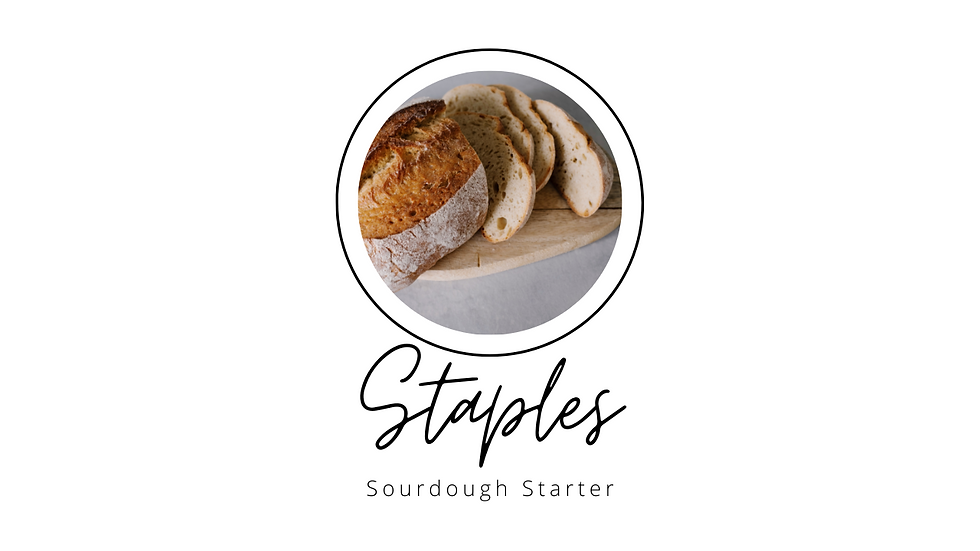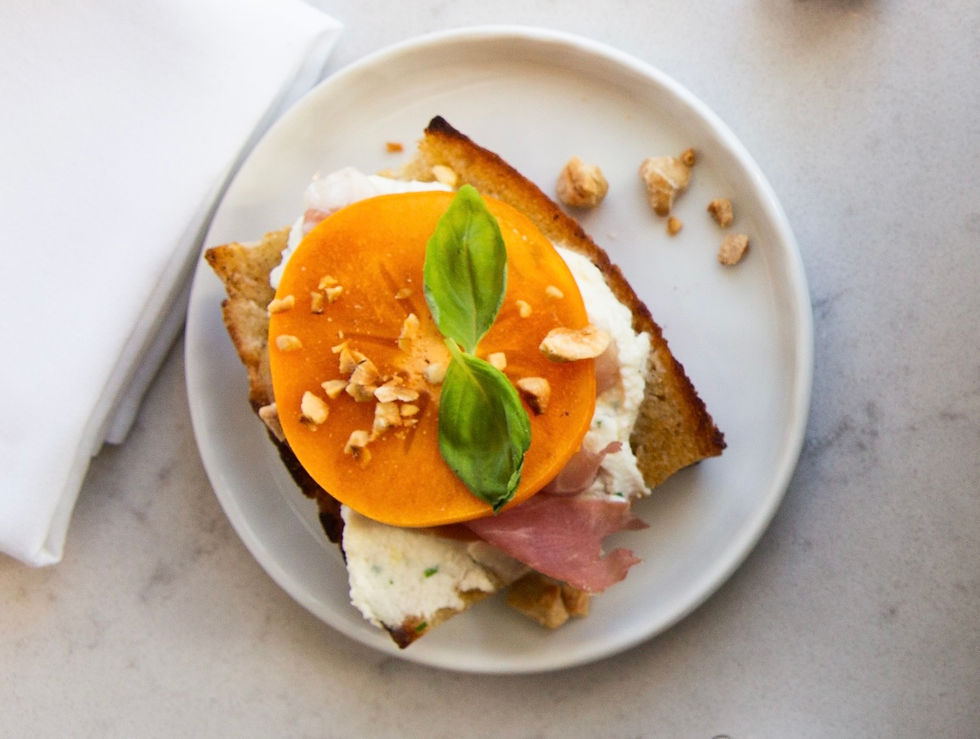
Sourdough starters might seem daunting, but they are actually not too scary. They do require some time initially, but as you get used to a schedule, starters are an appreciated part of the kitchen. They are great for not only baking bread, but also cakes, cookies, and pasta...queue a long list.
I have been making sourdough since 2017 and I knew nothing about it previously. I had a bread mentor in a local chef who showed me the ropes in 6 sessions. Since then, I have made my own starter and created a sourdough bread recipe that works for me. Practice and patience is key. So, no matter your level, you can make your own sourdough starter!
______
The Starter Recipe
Create a Starter:
1 & ½ teaspoons (or a packet) of Active Dry Yeast
2 Cups (11 oz) of Bread Flour
2 Cups (16 oz) of Water at 70-75°F
Use a container like a jar that you can put a lid on. Avoid a metal bowl for your starter as that will impact the temperature of your starter. You can use measuring spoons/cups or a digital scale. Digital scales tend to be more accurate. You will also need a thermometer to take the water temp.
Step 1 – Put 2 cups of Bread Flour in a bowl/container.
Step 2 – Pour in Active Dry Yeast and stir with flour.
Step 3 – Measure 2 cups of water and take its temperature. 70-75°F is ideal for the temp, but if your home runs cooler or warmer, make adjustments. Like I'd do 80-85°F for a colder home. Yeast likes warmth and it encourages activity.
Step 4 – Gradually pour in the water, while stirring with a spatula. Stir until well incorporated. I like to stir for a few minutes to encourage the yeast to be active. Let it hang out on the counter.
You’ll notice it will become active and bubbly within hours. Let it hang out for about 4 days. Stirring occasionally throughout the day to encourage the yeast to be active. You will notice that it will start to smell sour and a liquid will form on the top. This is all part of the process and it is fine. By day 4, feed the starter.
To Feed:
Step 1 – Stir the starter for a few minutes. Do not pour off the liquid. Some recipes do this, but I disagree as it’s just a part of the starter.
Step 2 – Discard about ½ to 1 cup of starter. I do a cup. You can dispose of the discarded starter.
Step 3 – Pour in 1 cup (8 oz) 70-75°F water and stir.
Step 4 – Pour in 1 cup (5.5 oz) of flour and stir. Stir as long as you can to encourage activity.
Store the starter for a few more days on the counter. Feed once a day. Once the starter is pretty active, you can continue to keep the starter on the counter and feed daily, or you can move the starter into the refrigerator.
Once in the fridge, feed once a month to keep the starter active. To get the starter ready for use, feed (2-3 times) and leave on the counter for a few hours to a couple days to allow it to warm up. Once the starter is bubbly and active, it's ready to be used. If it's not showing activity, feed again and leave longer. I call this process waking up the starter. Strong starters may not need as much time to wake up, and weaker starters might need more time and feedings to wake up. It just depends.
______

Common Questions
What is happening in the starter? Protein in the flour forms gluten. Yeast eats gluten and it produces CO2. The gluten helps the bread have strength and gives it rise. The water in the starter is helping the yeast move around and encourages the integration with gluten. Also, yeast likes warmth and movement. So, the water temperature and the movement of the stirring encourage the activity.
There's no yeast in the stores? A real issue in 2020 (possible again). You can always give a look online to purchase, but if that leads to no yeast there’s no need to panic as you can start starters from wild yeast. A popular sub is pineapple juice (Breadtopia), which is easily accessible to anyone. I personally have started a sourdough starter from wine grapes and the starter is still alive today...some daysit's too alive, haha!
I’m gluten-free? Okay! Well, there are sourdough starters that are gluten-free…I found this on King Arthur's site.
Bread Flour vs. All Purpose Flour? Bread Flour has a higher gluten percentage than All Purpose Flour (AP), which is why it is used for baking bread. The typical percentages are below:
All Purpose is 10.5%
Bread Flour 12.5%
High Gluten Bread Flour 14%
The more gluten you have for the yeast to eat...the more activity you will have. That said if all you have is All Purpose or Wheat, making a starter will still work! I'd recommend feeding with whatever flour you start the starter with.
Storing the starter?
Method 1: Store on the counter and feed daily. This is great if you are a baker and bake daily. Probably not doable for most folks though.
Method 2: Store the starter in the fridge and feed once a month. This is my preferred method.
The cold will cause the starter to slow down in activity. Upon removing from the fridge for use, feed the starter 2 times a day for 2 days to awaken the starter. How many feedings and how long on the counter depends on the starter's strength...may be more or less. Some starters I've worked with need 1 feeding and 30 minutes of wake up, but they are used more frequently.
Some starters can be kept in the fridge without feeding for up to a month or more. I would say this depends on the strength of your starter. If it's super active, then it will do great.
Method 3: You can dry the starter on parchment during feeding. Take some of the starter and just spread it out on parchment paper and let it dry for a couple of days. Then put the starter flakes in a container like a mason jar. I recommend this for any starter you are discarding during feeding to have a back up plan. Here's the article on King Arthur's site.
What is the liquid on top of the starter? So, believe it or not, this is called hooch and that's because it is technically alcohol...the byproduct of the activity between yeast and gluten. It is okay and it doesn't mean that your starter is bad. Stir it into the starter and then feed your starter.
How can you tell if it has gone bad? Starters share a lot about themselves via smell. Sweeter means that it has been fed and is happy. Sour means that it is probably needing food.
Acetone and funky smells equal something is awry. You just want to start feeding the starter, like you would when waking it up, to try to save it.
Mold, or discoloration is a bad sign. Just try your best to feed and save, but I would look at your saved dry starter at this point.
At feeding it feels wasteful, can I make something with the discarded (pitched) starter? Yes! Pancakes are a well-known option, but there are plenty of things you can do with pitched starter. You can dry some for storage. You can also give the pitched starter to someone else. Starter = giving.
How to know if your starter is ready for use? The visual activity of the bubbles will indicate its activity level, but again the smell is important. In Tartine’s Bread, the sweeter a starter smells the more ready for use. The more sour means more feeding and time. I will say that with time you will get to know your starter and will have a feeling.
Another method is the Float Test. Take some of the starter (like a little piece) and put it in water. If it floats, it’s ready for use. If it doesn’t float, well, it’s not ready. This is not always accurate, keep in mind, according to some bakers.
Can you bake with whatever flour and the starter? You can bake with whatever flour you would like. Some recipes use blends for more flavor. You will get different textures and densities as well. Bread flour due to its higher gluten percentage will have better crumb (meaning the texture and hole pattern in the bread will be more desirable for the sourdough).
How sour does the sourdough get? The sourness of sourdough is just what the starter decides to create. It's the nature of your starter. So, do not be surprised if it is not super sour. If you want more sourness to your sourdough bread, try using more starter in the recipe. Or try longer fermentation when making the dough.
Ideas for best bakes with sourdough bread? You need steam for sourdough bread. Dutch ovens are awesome and easy to use when at home. Use parchment paper to transport the bread in and out of the dutch oven.
Let's say you don’t have a dutch oven or a cast iron with a lid, instead use a water bath in your oven. Fill up a oven safe baking dish/roasting pan with water and place in the bottom of your oven. You will remove the dish 1/2 way through the bake.
This write-up had some great ideas for getting steam going in your oven: https://truesourdough.com/3-ways-to-make-amazing-sourdough-bread-without-a-dutch-oven/
Best ways to store bread? Wrap in parchment, saran wrap, and then leave on the counter. The bread will last about 4-5 days. You can also wrap the bread in parchment and saran wrap and put it in the freezer for long-term keeping. I'd recommend cutting slices before freezing as it will defrost more quickly and use as needed instead of committing to a whole loaf. Another recommendation is to label the bread so you know what it is a month or so later.
That was quite the sourdough write-up, but I hope this elevates any sourdough starter fears. This is a great project for kids. If you are on the fence about a pet, start the kids out with a sourdough starter and see if they can be responsible for it. No harm, no foul if the starter dies. No matter your situation, this is a great way to become more independent from processed foods and create your own delicious bread.
My next goal is to start milling my own flour, so once I do, I'll share about that. In the mean time, happy baking!

Comments